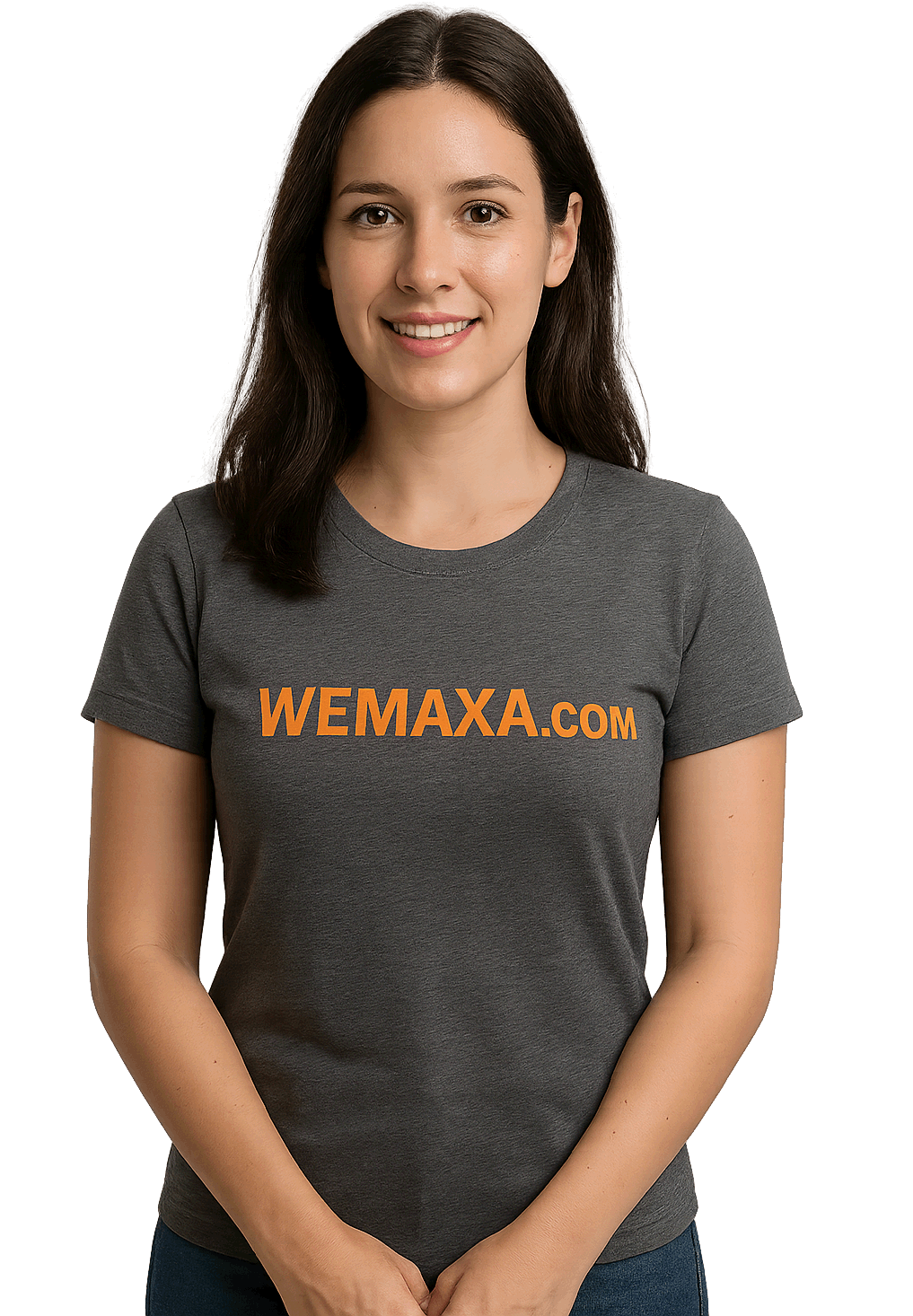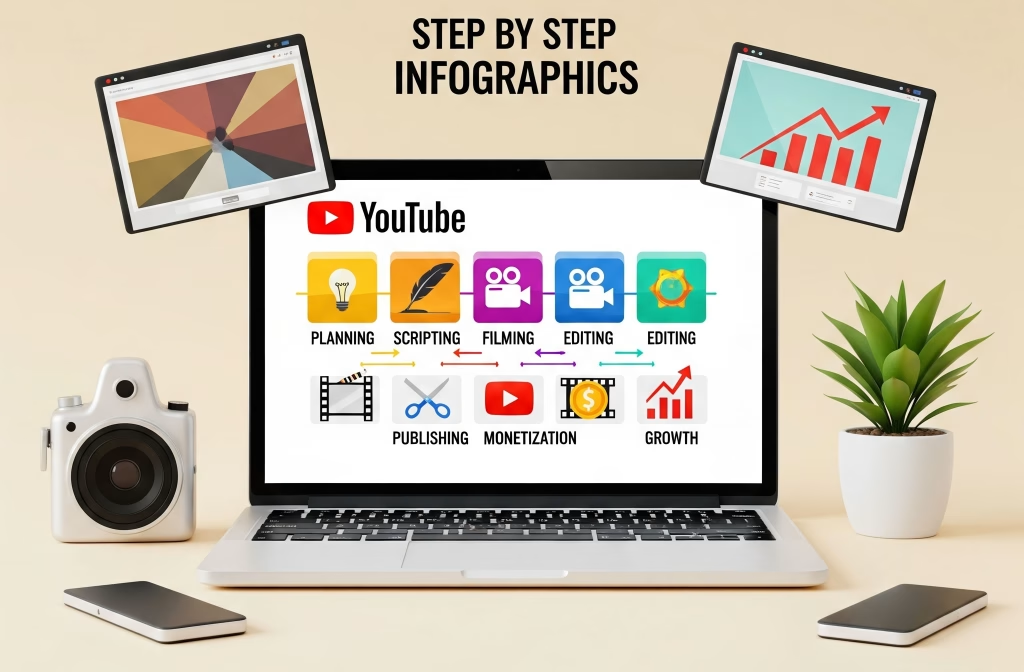
YouTube Content Creation Guide
We walk creators through planning filming editing optimization monetization and growth. The emphasis is on narrative consistency branding and analytics driven iteration.
Key phases
- Story structure and rough to fine cut: plan pacing with a rough cut then refine for rhythm and engagement
- Editing software: Premiere Pro Final Cut Pro DaVinci Resolve for professionals; Premiere Rush or iMovie for beginners
- Organization and workflow: folder structure proxies backups and render presets to speed production
- Visual and audio polish: color correction and grading EQ compression and sound design for consistent quality
- Graphics and branding: thumbnails lower thirds simple intro sequence and consistent metadata
- Distribution and formats: long form videos Shorts and repurposed clips for cross platform reach
- Analytics and iteration: retention graphs A B testing and hypothesis driven experiments
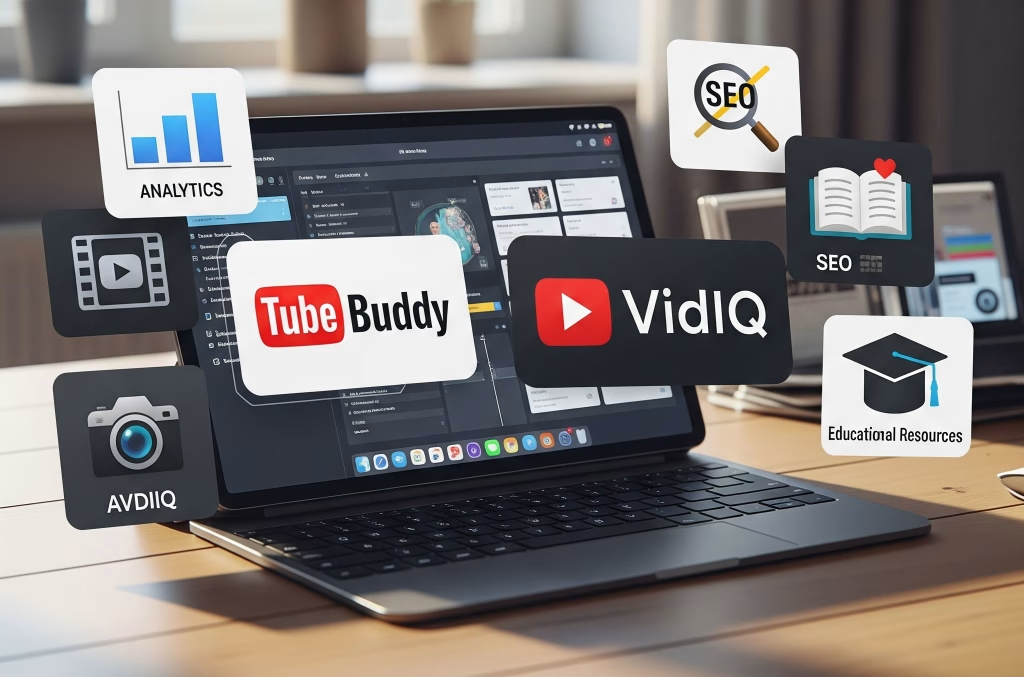
Tools and services
- YouTube Creator Academy — official tutorials and best practices
- Hootsuite guide to growing on YouTube — practical channel strategies
- Kajabi beginner guide — setup strategy monetization overview
- TubeBuddy — SEO tags thumbnail A B testing tools
- VidIQ — analytics and keyword research tools
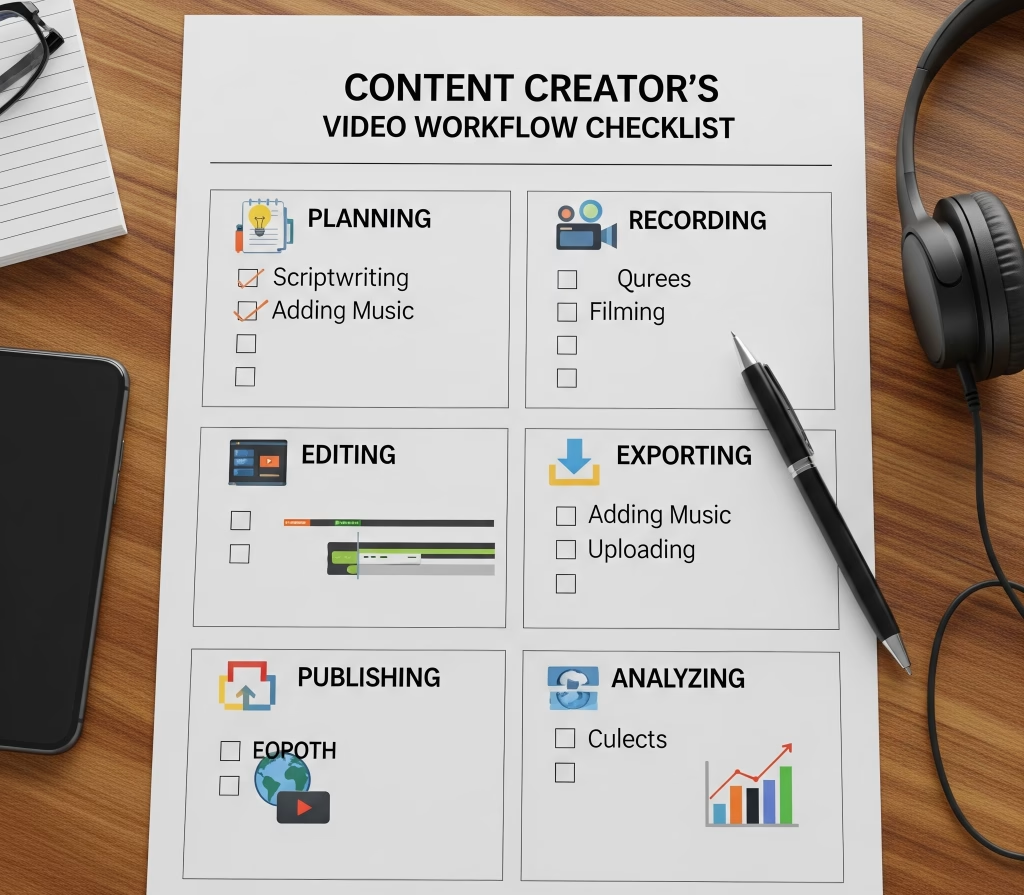
Community perspective
Real creator experiences help set expectations for growth and persistence.
Quick implementation checklist
- Plan script and hook for first 10 seconds
- Record with steady framing and clear audio
- Make a rough cut then tighten pacing
- Export masters and create platform specific versions
- Publish with optimized title tags and pinned comment
- Review analytics after 48 hours iterate accordingly
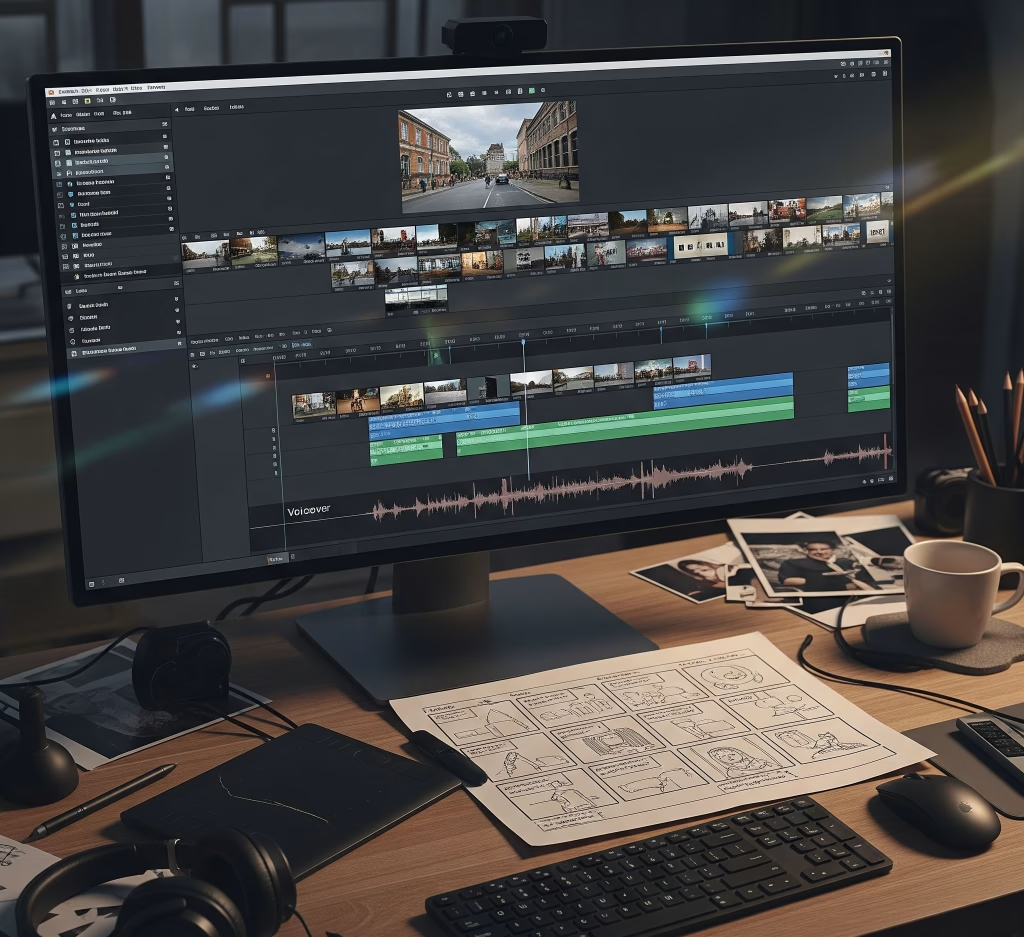
Building the Narrative
Editing begins with the rough cut, which is essentially assembling the story in its simplest form. The goal here is not beauty but structure. All necessary clips are placed in sequence, errors and pauses trimmed out, and the basic flow of the video established. For a vlog, this might mean piecing together travel clips chronologically, while for a tutorial it means arranging explanation segments in logical order. Voiceovers, if used, are laid down early to provide pacing. Many editors advocate for “editing with your ears first”: listening to how the video sounds when played back rough, since audio pacing often dictates rhythm more effectively than visuals. The rough cut is also the stage where unnecessary tangents are removed viewers have limited patience, and attention must be earned by maintaining forward momentum. After this skeleton is complete, the fine cut refines each moment.
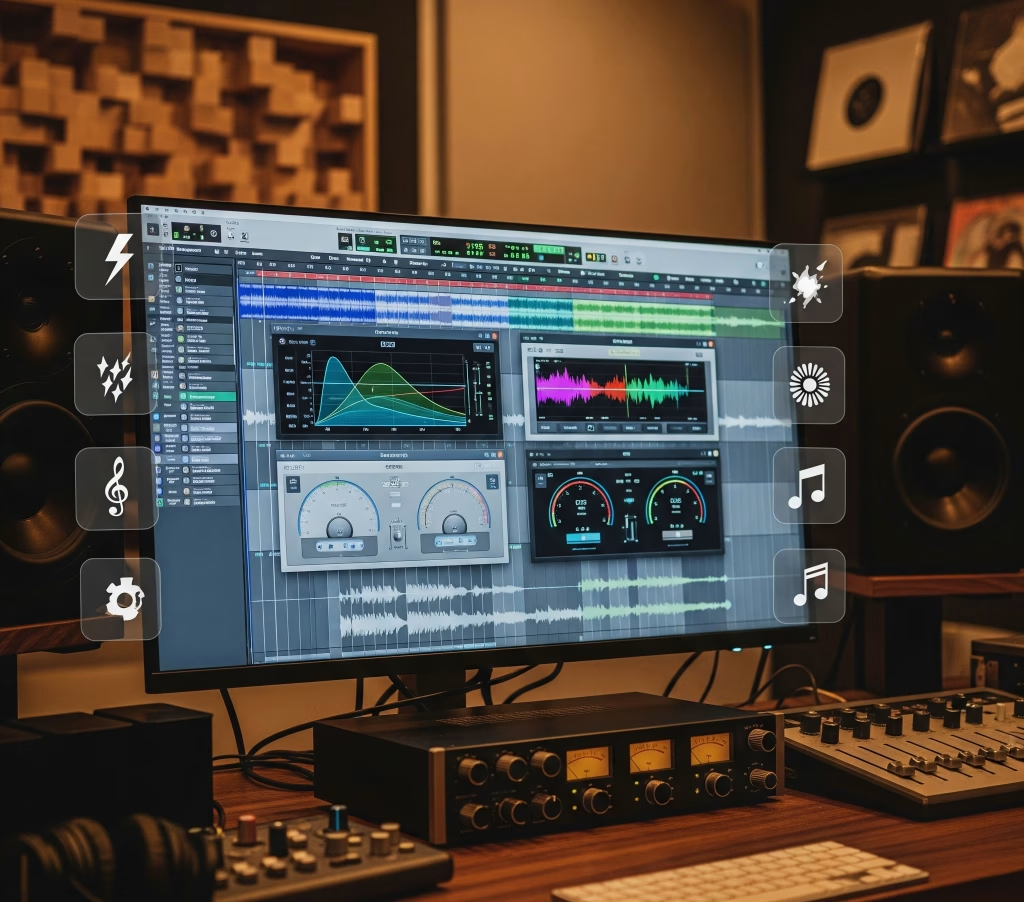
Audio Mastering and Sound Design
While microphones capture the raw sound, editing refines it into clarity. Equalization (EQ) enhances voices by cutting muddy low frequencies and gently boosting mids where speech resides. Compression reduces the gap between quiet and loud moments, ensuring the viewer doesn’t need to constantly adjust volume. Noise reduction tools, available natively in most suites or via plugins like iZotope RX, remove hums, hisses, or background distractions. Beyond cleanup, sound design adds dimension: subtle ambient noise in travel vlogs, swooshes to accent transitions, or risers to build suspense. These small details differentiate professional channels from amateur ones. Mastering involves balancing all elements dialogue, effects, and music so no single track dominates. Export levels should aim for consistent loudness around -14 LUFS, which is the streaming standard. Overly quiet videos risk abandonment, while overly loud ones may be rejected by the platform.
Transitions, Graphics, and Motion Elements
Visual polish often comes from transitions and motion graphics. While flashy wipes and spins can appear amateurish if overused, subtle cross dissolves, fades, or well-timed jump cuts enhance narrative flow. Branding assets such as animated intros, lower thirds (text labels), and end screens should match the channel’s visual identity in fonts, colors, and design. After Effects or Motion are powerful for building custom animations, but even free template libraries provide professional assets. Many successful creators establish a consistent visual package that viewers recognize instantly: a particular intro sting, a certain style of title cards, or recurring graphic motifs. Consistency across episodes not only elevates professionalism but also strengthens channel branding, turning casual viewers into subscribers who feel they’ve entered a familiar creative world each time they click.
Exporting and YouTube Settings
The final step is exporting, and here technical knowledge directly affects video quality. YouTube recommends H.264 encoding with an MP4 container, though H.265 (HEVC) is gaining traction for higher efficiency. Bitrate should balance quality with file size: around 8 Mbps for 1080p, 16–20 Mbps for 4K. Frame rate should match the source footage forcing mismatched frame rates creates stutter. Audio should be exported in AAC format at 320 kbps for maximum clarity. Naming conventions matter at this stage too: including version numbers avoids overwriting previous exports. Once uploaded, creators should check playback on multiple devices desktop, mobile, and television to ensure colors, subtitles, and audio mix remain consistent across platforms. Optimizing thumbnails, metadata, and closed captions at this point ensures that the polished content reaches its intended audience with maximum discoverability.
Importing and Organizing Footage
The editing process begins with a meticulous import routine. Raw clips are transferred from SD cards or external drives into a structured folder system. A common practice is to separate files into folders labeled “A-roll” for primary talking head footage, “B-roll” for supplementary visuals, “Audio” for separate microphone recordings, and “Graphics” for intros, lower thirds, or thumbnails. Editors working on large projects use metadata tagging or software-integrated bins to catalog clips by scene, camera angle, or shooting day. Proper organization reduces wasted time searching for files during editing, which is crucial when deadlines are tight or when multiple projects run concurrently.
Graphics, Titles, and Visual Enhancements
Graphics and text overlays add polish and branding. Lower thirds introduce speakers, motion graphics highlight statistics, and animated subscribe reminders encourage viewer interaction. Adobe After Effects is the industry leader for advanced motion graphics, though built-in tools in Premiere, Final Cut, or DaVinci can handle simpler text animations. Many creators also rely on stock graphic packs or subscription libraries for templates, ensuring a consistent aesthetic across their videos. For tutorial creators, screen capture software such as OBS Studio or Camtasia allows seamless integration of desktop footage with annotations or pointer effects.
Exporting and Upload Optimization
Once the final cut is complete, export settings must balance quality with file size. Most YouTubers export in H.264 codec at 4K or 1080p resolution, depending on source footage. Bitrate recommendations vary, but YouTube suggests 8–12 Mbps for 1080p and 35–45 Mbps for 4K uploads. Audio should be exported at 320 kbps for clear playback. Naming conventions should include project details and dates to avoid confusion in archives. After export, videos are uploaded to YouTube Studio, where additional optimization occurs: custom thumbnails, keyword-rich descriptions, end screens, and cards. Proper metadata not only increases discoverability but also positions the video for better monetization. Reference: YouTube Encoding Settings.
Thumbnails: The First Impression
On YouTube, thumbnails are the digital equivalent of a storefront window. No matter how polished the video, weak thumbnails suppress click-through rates. A strong thumbnail communicates the topic instantly, uses bold colors to stand out against the crowded YouTube interface, and often features close-up expressions or key objects relevant to the video. Professional creators design thumbnails with tools like Adobe Photoshop or the simpler Canva Pro, where templates speed up the process. A/B testing different designs through YouTube’s experiments or third-party tools allows data-driven refinement. Importantly, thumbnails must avoid clickbait exaggerations that disappoint the audience; authenticity combined with visual clarity leads to higher long-term engagement. Reference: Canva Thumbnail Templates.
Titles, Descriptions, and Metadata
While thumbnails drive clicks, titles and descriptions determine discoverability. A good title balances intrigue with clarity, integrating target keywords naturally without sounding robotic. Descriptions serve multiple roles: they summarize the content, include links to products or affiliate programs, and provide timestamps for easy navigation. YouTube’s algorithm also favors videos that provide context through tags and metadata. Creators should conduct keyword research using tools such as TubeBuddy or VidIQ to identify trending phrases, then integrate them strategically in titles, descriptions, and tags. This optimization is part of postproduction just as much as color grading or audio mixing, because it directly affects reach. Reference: VidIQ.
Brand Identity and Consistency
Postproduction also extends into branding. A consistent color palette, intro sequence, and outro design help viewers instantly recognize a creator’s content. Logos, channel banners, and watermarks reinforce identity across multiple videos. Larger creators often develop brand kits collections of fonts, graphic overlays, and color schemes that ensure consistency even when outsourcing editing. Branding influences perception: a chaotic channel design suggests amateurism, while cohesive design projects professionalism. For creators aiming at monetization, consistency is not optional; it signals reliability to viewers and potential sponsors alike.
Monetization Basics: AdSense and Beyond
The most common entry point for monetization is the YouTube Partner Program, which allows creators to earn revenue from ads displayed before, during, or alongside videos. To qualify, channels need 1,000 subscribers and 4,000 watch hours in the past 12 months. While AdSense revenue can be meaningful for high-traffic channels, it fluctuates heavily with CPM rates, niche focus, and seasonality. Gaming channels, for example, often face lower ad rates than finance or tech channels. Successful creators therefore diversify income streams early, treating AdSense as one pillar rather than the entire business model. Reference: YouTube Partner Program.
Affiliate Marketing and Product Placement
Affiliate marketing is an accessible path to monetization. Creators insert affiliate links in descriptions or pinned comments, earning a commission for sales generated through their audience. Amazon Associates is the most popular program, though niche-specific platforms often pay higher rates. Product placement represents the next step: brands pay creators to integrate products into their videos, ranging from casual mentions to scripted demonstrations. For these deals, authenticity is critical. Audiences quickly detect forced endorsements, and trust lost is rarely regained. A creator who builds a reputation for honesty can command higher sponsorship rates in the long term.
Merchandise and Digital Products
Beyond ads and affiliates, creators can monetize directly through merchandise sales. Platforms like Teespring, Spreadshop, or Merchbar integrate with YouTube, enabling creators to showcase branded apparel beneath their videos. Digital products, such as e-books, presets, templates, or online courses, often yield higher margins. For example, a filmmaker might sell LUTs for color grading, while a fitness creator could offer structured training guides. Unlike ad revenue, which is volatile, merchandise and digital products build durable revenue streams that reward loyal audiences. Reference: Teespring.
Community Support and Crowdfunding
Platforms like Patreon, Buy Me a Coffee, and YouTube’s own Membership feature allow creators to monetize through community support. Fans pay monthly subscriptions in exchange for perks like exclusive videos, live Q&A sessions, or behind-the-scenes content. Crowdfunding campaigns on Kickstarter or Indiegogo are also viable for large projects, such as producing a documentary or launching a new product line. These systems convert engagement into sustainable income, reducing reliance on algorithm-driven ad revenue. The key is offering tangible or emotional value that justifies recurring support.
Analytics and Continuous Improvement
Finally, postproduction includes ongoing analysis. YouTube Analytics provides granular insights into audience retention, click-through rates, and demographic breakdowns. High drop-off points signal pacing problems, while spikes in rewatching indicate segments worth highlighting in future content. Experimentation is essential: adjusting upload times, video lengths, or formats while monitoring metrics allows creators to refine their approach systematically. Data-driven postproduction is the invisible engine of monetization, turning creative expression into a repeatable business model. Reference: YouTube Analytics.
Live Streaming: Real-Time Engagement
Live streaming on YouTube adds a layer of immediacy and authenticity that pre-recorded videos cannot replicate. It allows creators to interact directly with viewers through live chat, Q&A sessions, and polls, fostering a stronger sense of community. Technically, live streaming requires a stable internet connection with upload speeds of at least 6 Mbps for 1080p streaming. Software like OBS Studio and Streamlabs OBS dominate the landscape, offering customizable overlays, scene transitions, and integration with alerts for donations or subscriptions. For professional setups, hardware encoders such as the Elgato Stream Deck or Blackmagic ATEM Mini provide additional reliability and production polish. Creators who consistently stream develop higher viewer loyalty, as audiences come to expect a shared routine. Reference: OBS Studio.
Collaborations: Expanding Reach
Collaboration is one of the most effective growth strategies on YouTube. By appearing in another creator’s video, both parties cross-pollinate their audiences, often leading to subscriber boosts on both sides. Successful collaborations are based on genuine compatibility rather than opportunism; mismatched tones or audiences can feel forced and alienate viewers. Collaboration also extends to behind-the-scenes cooperation sharing editors, graphic designers, or social media managers can streamline production and increase output without sacrificing quality. The key is reciprocity: both creators should benefit in terms of exposure or creative enrichment, otherwise the partnership risks imbalance.
Traffic Source Evaluation
Identifying where viewers discover videos guides promotional strategies. Traffic sources include YouTube search, external websites, suggested videos, playlists, Shorts shelf, or social media platforms. Analyzing traffic origin informs which marketing channels to prioritize, how to optimize titles and thumbnails for search, and how to structure content for algorithmic recommendations. External traffic evaluation also helps determine the effectiveness of cross-platform promotion, collaborations, and newsletter campaigns in driving consistent viewership.
Experimentation and Iterative Improvement
Continuous improvement relies on structured experimentation. Creators can A/B test thumbnails, titles, video formats, or posting times to determine optimal strategies. Observing analytics before and after adjustments reveals causality between content changes and performance outcomes. Experimentation must be documented, and results tracked over time to avoid randomization. Iterative improvement ensures that successful tactics are scaled, underperforming strategies are modified, and creative growth is grounded in data-driven insights rather than guesswork.
Audience Feedback and Surveys
In addition to quantitative data, qualitative insights from audience feedback are invaluable. Comments, polls, direct messages, and community posts provide context that metrics alone cannot capture. Surveys and questionnaires allow creators to gauge viewer preferences, content interest, and unmet needs. Incorporating audience suggestions strengthens community engagement, fosters loyalty, and guides content planning. Feedback loops complement analytics, ensuring that channel evolution aligns with both data trends and audience expectations.
Benchmarking and Competitive Analysis
Comparing performance against similar channels helps identify best practices, niche opportunities, and content gaps. Benchmarking involves analyzing competitor upload frequency, video length, engagement rates, and trending topics. Understanding competitive performance enables creators to differentiate their content, improve production quality, and adopt effective promotion strategies. Competitive analysis is particularly valuable for micro-niches, where subtle differences in execution and presentation can result in significant audience growth advantages.
Importance of Community for Channel Growth
A strong community transforms passive viewers into active advocates, driving organic growth and sustained engagement. Channels with dedicated communities benefit from higher watch time, more consistent engagement, and greater resilience to algorithm changes. Community building fosters loyalty by creating a sense of belonging, allowing viewers to participate in content decisions, and encouraging interaction both on YouTube and across associated platforms. A thriving community can also amplify promotion, share content voluntarily, and provide feedback to refine future videos.
Engaging Viewers in Comments and Discussions
Responding to comments, answering questions, and acknowledging viewer contributions demonstrates attentiveness and fosters a personal connection. Active participation encourages more audience members to comment, creating a feedback loop that signals engagement to YouTube’s algorithm. Structured strategies include pinning insightful comments, asking discussion prompts, and highlighting viewer contributions in videos. Over time, comment interaction reinforces loyalty and increases watch time as audiences return for personalized engagement.
Live Streaming and Real-Time Engagement
Live streaming enables immediate, unscripted interaction, creating a deeper connection between creators and their audience. Live Q&A sessions, tutorials, gaming streams, or event coverage provide direct engagement opportunities. Features like Super Chats, donations, and live polls enhance revenue and participation simultaneously. Preparation is essential: a stable internet connection, reliable audio/video setup, and moderation of live chat are critical for smooth execution. Consistent live sessions build routine, reinforce loyalty, and allow creators to respond to audience interests dynamically.
Fan Recognition and Highlighting Supporters
Recognizing loyal fans strengthens emotional bonds and encourages repeat engagement. Strategies include showcasing fan art, comments, video responses, or featuring supporters in videos. Membership tiers or VIP programs can provide exclusive access, badges, or early content to incentivize consistent participation. Transparent acknowledgment of viewer contributions reinforces trust, encourages advocacy, and creates a self-sustaining community where active members help maintain channel momentum.
External Community Platforms
Expanding community interaction beyond YouTube mitigates platform dependency and fosters multi-channel engagement. Discord servers, Slack groups, private Facebook communities, or subreddit forums create spaces for more in-depth discussion, collaboration, and peer-to-peer networking. External platforms also allow creators to test new content, gather qualitative feedback, and coordinate collaborative projects. A well-moderated external community enhances the overall ecosystem, strengthens loyalty, and supports monetization strategies through memberships or exclusive content.
Importance of Consistent Branding
Branding is a critical component of channel identity and audience recognition. A consistent brand helps viewers immediately identify content, reinforces trust, and establishes a professional presence. Visual elements such as logo design, color schemes, typography, and graphics should be consistent across video intros, thumbnails, banners, social media, and merchandise. Consistency in tone, language, and presentation style further strengthens brand perception. Effective branding differentiates a channel in a crowded ecosystem, making content memorable and fostering long-term audience loyalty.
Ad Revenue and YouTube Partner Program
The YouTube Partner Program (YPP) is the primary revenue source for many creators. Eligibility requires at least 1,000 subscribers and 4,000 watch hours in the past 12 months. Ad revenue is generated through display ads, overlay ads, skippable and non-skippable video ads, and bumper ads. Factors affecting earnings include niche, audience demographics, watch time, and advertiser demand. Channels targeting high-value demographics such as tech, finance, or professional development tend to attract higher CPMs (cost per thousand impressions). Effective ad placement, video length optimization, and audience retention strategies maximize ad revenue without negatively impacting viewer experience.
Collaboration Across Platforms
Cross-platform collaborations can magnify reach beyond YouTube alone. Influencers from Instagram, Twitch, or TikTok may feature each other in content, share one another’s videos, or co-host live sessions. Multi-platform campaigns increase discoverability for both parties, attract different audience segments, and build credibility through association. Creators often coordinate content calendars to release complementary pieces simultaneously, reinforcing messaging and maximizing impact. These collaborations may also involve brand partnerships that span multiple channels, providing more lucrative opportunities than single-platform campaigns.
Paid Promotion and Analytics
While organic reach forms the foundation of growth, paid promotion can accelerate channel visibility. YouTube Ads, Google Ads, or sponsored placements on other social platforms allow creators to target specific demographics, interests, or geographies. Paid campaigns should be data-driven: tracking click-through rates, conversions, watch time, and cost-per-view ensures efficient allocation of resources. Over time, analytics reveal which campaigns deliver the best ROI and inform adjustments in creative strategy. Paid promotion complements organic growth but must be integrated thoughtfully to maximize both immediate impact and long-term channel development.
Analyzing Trends Without Losing Identity
Trends drive short-term traffic, but blind chasing can erode a channel’s brand identity. Successful creators monitor trends via YouTube’s Trending tab, Google Trends, or industry-specific news sources, then evaluate whether the topic aligns with their audience and niche. For example, a tech reviewer may capitalize on a new smartphone launch by providing in-depth analysis rather than a superficial unboxing. Balancing trend-driven content with evergreen material ensures both consistent growth and long-term value. Additionally, analyzing competitor performance on trending topics helps creators anticipate which angles have untapped potential and avoid redundancy.
Content Calendar and Consistency
Consistency is not only about posting regularly; it is about predictable delivery that audiences and algorithms recognize. Many creators maintain content calendars that map out upload dates, themes, and production milestones weeks or months in advance. Planning reduces creative fatigue, allows batching of filming and editing tasks, and ensures seasonal relevance for topics. For instance, a fitness channel might schedule “New Year Resolution” content in December, while a tech channel aligns gadget reviews with product release cycles. Consistent frequency also signals to YouTube’s recommendation algorithm that the channel is active, improving visibility across subscriptions, homepage placements, and suggested videos.
Monetization Potential of Shorts
While Shorts monetization differs from traditional long-form content, opportunities exist. The YouTube Shorts Fund previously rewarded high-performing creators directly, though the platform increasingly integrates Shorts into general revenue streams. Brand sponsorships and product placements can be tailored for short content, particularly in niches like tech, fashion, or fitness where quick demonstrations are effective. Additionally, Shorts drive traffic to long-form videos and membership options, indirectly supporting monetization. Strategic use of vertical content strengthens the channel ecosystem, ensuring multiple revenue pathways and audience touchpoints across formats.
Leveraging Social Media for Channel Growth
YouTube success increasingly depends on multi-platform promotion. Relying solely on organic search and algorithmic recommendations limits potential reach. Platforms like Instagram, TikTok, Facebook, Twitter/X, and LinkedIn serve as amplifiers, allowing creators to share highlights, trailers, or behind-the-scenes content. Instagram Reels or TikTok clips can act as teasers for full-length videos, while Twitter/X threads provide context, commentary, or links. Strategic posting times and platform-specific formatting maximize visibility. Consistency in messaging and branding across these platforms ensures that audiences recognize the creator immediately, regardless of the channel or medium.
YOUTUBE CONTENT CREATION GUIDE ON HOW TO CREATE, FILM AND UPLOAD YOUTUBE VIDEOS TO MAKE MONEY
YouTube has grown into the cultural equivalent of television for the digital era, a platform where billions of viewers converge daily, seeking information, entertainment, and companionship. To stand out in this crowded arena, a creator must understand that success rests on more than personality: it requires strategic planning, thoughtful subject selection, and a realistic monetization roadmap.
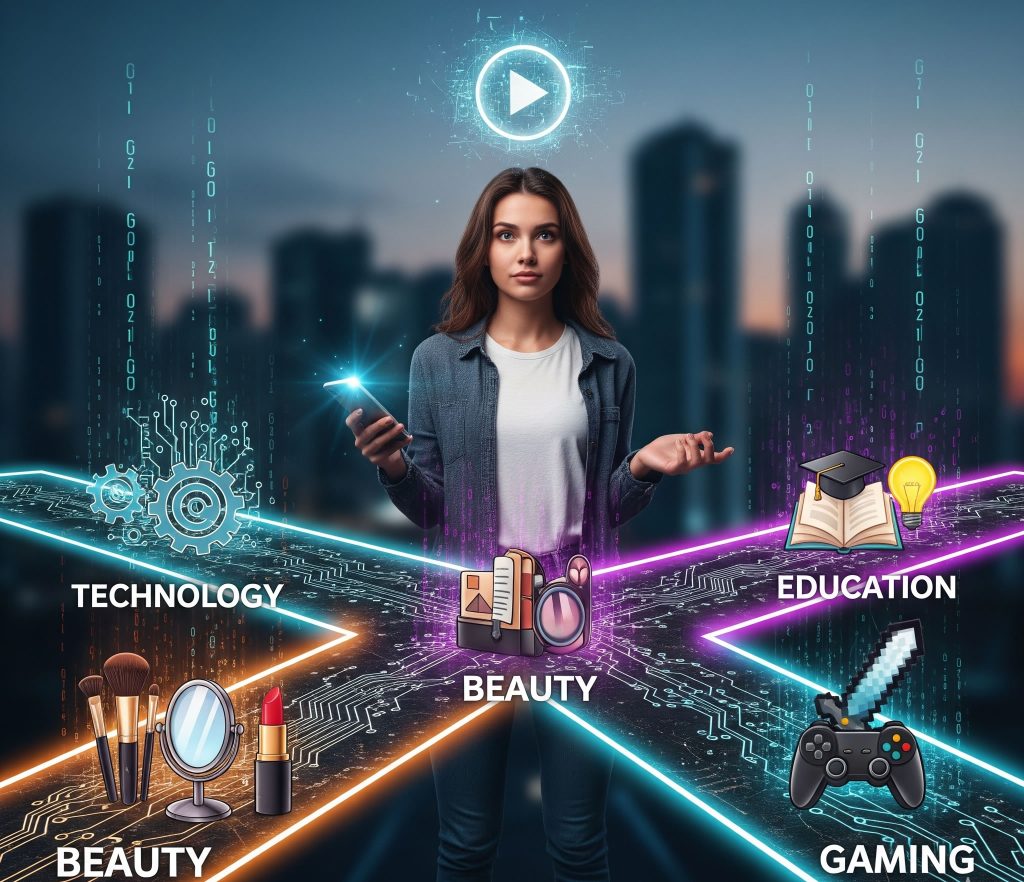
The journey always begins with a simple but vital question what should I make videos about? The answer determines not only your audience but also the monetization options available later. Popular evergreen categories include technology reviews, beauty tutorials, gaming highlights, educational explainers, travel diaries, personal finance insights, and fitness instruction. Choosing a niche that aligns with your own expertise and enthusiasm creates authenticity, while ensuring the subject has demand creates scalability.
The creator economy rewards focus: channels that stay within one central theme tend to build loyal subscriber bases more quickly than those that scatter across unrelated topics. Yet focusing does not mean being repetitive; it means building a recognizable identity. For instance, a technology creator might cover smartphone launches, software guides, and industry commentary all related but distinct angles that appeal to overlapping demographics. The goal is to give viewers a reason to return regularly, and to encourage the algorithm to recognize your channel as an authoritative source on that subject.
Monetization enters the picture once a creator reaches the YouTube Partner Program threshold: one thousand subscribers and four thousand public watch hours in the last twelve months, or ten million Shorts views in ninety days. At this point, ad revenue becomes available through display ads, overlay ads, skippable and non-skippable pre-rolls, and Shorts ads. Yet ads alone rarely generate substantial income unless a channel grows into the hundreds of thousands of subscribers. Serious creators diversify: affiliate marketing through product links, sponsorship deals negotiated with brands, and merchandise shops integrated with YouTube’s shelf all add to revenue streams. Super Chats and channel memberships create direct viewer-to-creator support, while Patreon or similar platforms extend income possibilities outside YouTube’s walls. For authoritative information on monetization requirements, see the official YouTube help page at YouTube Monetization.

Beyond eligibility, creators must master audience retention the measure of how long people watch before dropping off. Higher retention increases ad impressions and strengthens algorithmic recommendations. Crafting videos with a compelling hook in the first 15 seconds, maintaining narrative momentum, and ending with a clear value proposition are techniques that directly influence revenue. YouTube’s analytics dashboard reveals these patterns in granular detail, showing exactly when viewers abandon a video and where improvements can be made. In practice, monetization is not an end goal but an evolving process, refined by studying data, experimenting with formats, and listening to the audience.
Cameras: Choosing the Right Model
When selecting a camera for YouTube, the first distinction to make is between interchangeable-lens systems and fixed-lens compacts. Interchangeable-lens mirrorless models like the Panasonic Lumix GH7, Sony α6700, or Canon EOS R50 V offer long-term flexibility because you can build a lens collection to suit different scenarios. A wide-angle lens creates a sense of space and intimacy in vlogs, while a fast prime lens with an f/1.4 or f/1.8 aperture provides cinematic background blur for tutorials or interviews. On the other hand, compact cameras like the Sony ZV-1F or DJI Pocket 2 are designed for simplicity: fixed lenses mean fewer decisions, and stabilization is often built-in, making them great for beginners or travel vloggers who need lightweight gear. For creators on a strict budget, even modern smartphones can deliver impressive 4K video if paired with proper lighting and external microphones. However, limitations such as sensor size, overheating, and lack of depth control eventually push many to upgrade to dedicated cameras.
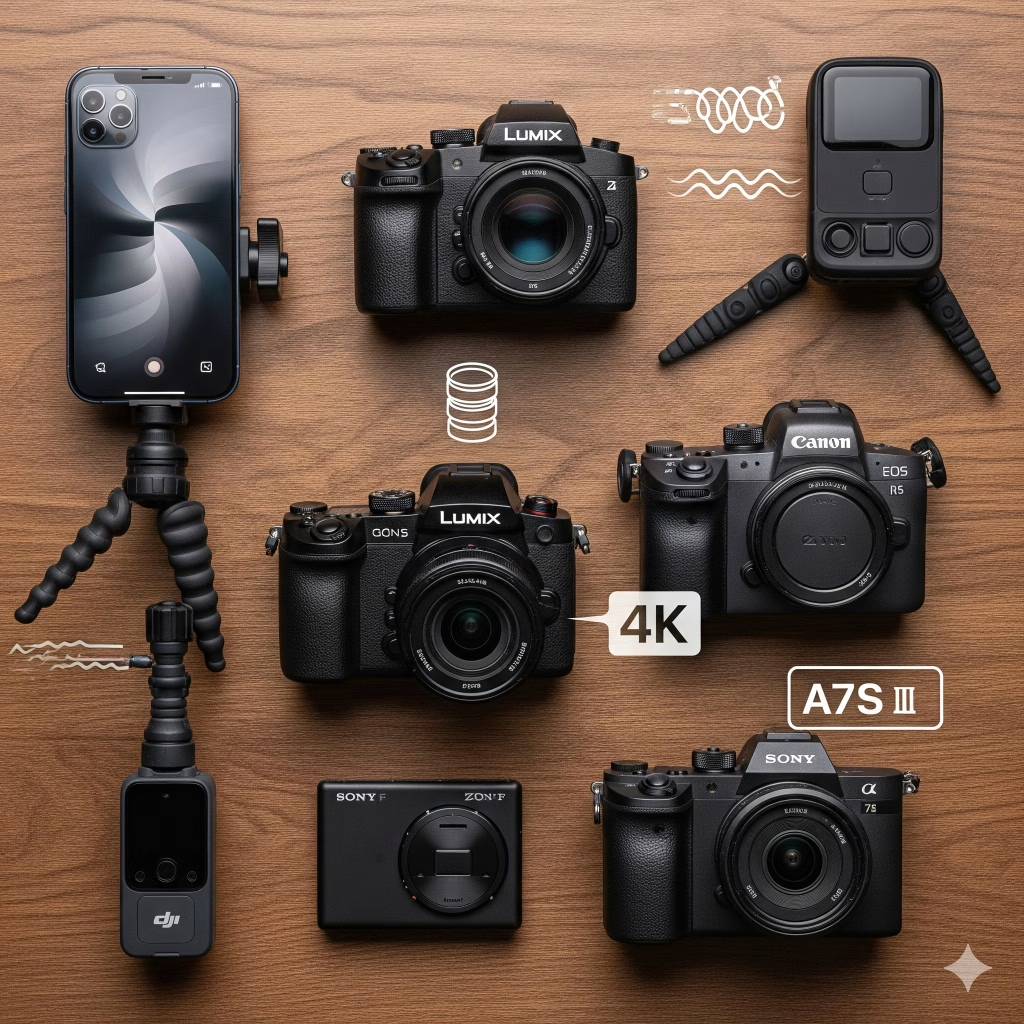
An important technical factor is the sensor size. Full-frame sensors, like those found in the Sony ZV-E1, excel in low-light conditions and produce a cinematic look with shallow depth of field, but they are expensive and often bulkier. APS-C sensors, such as in the Sony α6700, strike a balance between cost, portability, and image quality. Micro Four Thirds sensors, like the GH7, are smaller but allow lighter lenses, longer recording times, and extensive frame-rate options making them favorites among creators who shoot for extended sessions or need advanced slow-motion. Beginners should avoid over-focusing on resolution. 1080p remains sufficient for most viewers, and 4K is valuable mainly for reframing in post-production or delivering future-proof content. More relevant factors include dynamic range (how well a camera handles highlights and shadows), bit-depth (important for color grading), and autofocus reliability. In YouTube production, autofocus is critical because many creators film themselves; a system that smoothly tracks faces or eyes saves countless retakes.
Reliability also matters. Some cameras impose recording limits, such as 30 minutes per clip, while others overheat in long 4K sessions. Professional models with fan-based cooling or unlimited recording, like the Panasonic GH7, solve this. Storage and workflow must be considered: shooting 10-bit 4:2:2 footage produces beautiful images but consumes massive memory card and editing space. Creators need to weigh whether they prefer efficiency (smaller 8-bit H.264 files) or maximum flexibility (high-bitrate formats for color grading). External recorders, like those from Atomos, can bypass internal compression entirely and capture footage in ProRes for smoother editing, though this introduces another cost layer. The golden rule is to buy once and cry once invest in a camera that supports your growth for several years rather than cutting corners and needing an upgrade too soon. For detailed comparisons, see RTINGS: Best Cameras for YouTube.
Cameras: Entry-Level to Professional
- Selecting the right camera depends on budget, content type, and desired production quality. Entry-level creators often start with smartphones or mirrorless cameras like the Canon EOS M50 Mark II, Sony ZV-1, or Panasonic Lumix G100. These models offer excellent autofocus, low-light performance, and 4K recording capabilities. Intermediate creators may upgrade to full-frame mirrorless cameras such as the Sony A7 IV or Canon R6, which provide superior image quality, dynamic range, and lens flexibility. High-end setups include cinema cameras like Blackmagic Pocket Cinema Camera 6K or Canon C70, suitable for cinematic production and professional-level content.
Lenses and Accessories
- Lens choice impacts field of view, depth of field, and low-light performance. Wide-angle lenses (16–35mm) suit vlogs and interiors, while standard prime lenses (35mm–50mm) offer sharp image quality with natural perspective. Telephoto lenses (85mm–135mm) work for interviews or detail shots. Accessories such as tripods, gimbals, sliders, and external monitors enhance stability and framing. ND filters allow outdoor shooting without overexposure, and lens hoods prevent flare. Selecting compatible accessories ensures optimal utilization of camera features.
Multi-Camera Productions
- Advanced creators often employ multi-camera setups to add dynamism to their videos. By switching between wide shots, close-ups, and alternate angles, editors can maintain visual interest even during long segments of dialogue. This technique is especially popular in podcasts, interviews, and tutorial formats. Synchronizing footage from multiple cameras requires clapper boards or software-based audio sync tools. Editing platforms like Final Cut and Premiere include multicam editing modes that simplify angle switching in postproduction. While multi-camera shoots increase complexity, they elevate the perceived professionalism of the channel.
Selecting the Editing Software
Editing software is the control room where raw footage transforms into polished storytelling. The choice depends on skill level, operating system, and production goals. Adobe Premiere Pro remains the industry benchmark, trusted by professionals and large YouTube channels because of its compatibility with third-party plugins, advanced color grading tools, and tight integration with After Effects for motion graphics. Final Cut Pro, exclusive to macOS, is optimized for Apple hardware, delivering lightning-fast rendering with the magnetic timeline system that appeals to editors who prefer speed and simplicity. DaVinci Resolve has surged in popularity due to its free version, which includes professional-grade color correction, Fairlight audio tools, and a non-linear editing environment rivaling paid platforms. For beginners or creators who want quick results, Adobe Premiere Rush or Apple iMovie provide streamlined interfaces designed for drag-and-drop simplicity without overwhelming technical features. Whichever program is chosen, consistency is more important than complexity mastering one suite deeply yields better results than jumping between many. For detailed comparisons, see Adobe Premiere Pro, DaVinci Resolve, and Final Cut Pro.
- Organizing Footage
Before diving into cuts and effects, efficient organization saves time and frustration. A proper folder structure separates raw footage, audio, music, graphics, and exports. Within the editing software, creating bins or libraries that mirror this structure allows editors to find assets quickly. Many creators underestimate the importance of naming conventions, but labeling clips with descriptive terms such as “intro_talkinghead_take1” prevents chaos later. Professional workflows often include proxy creation lower-resolution copies of 4K or 6K clips that edit smoothly on less powerful computers. Once editing is complete, the software automatically links back to the full-resolution files for final export. This process not only accelerates editing but also reduces crashes and lag during complex timelines. Backups are essential as well: storing media on a fast SSD for active projects, while keeping raw footage duplicated on external HDDs or NAS systems, ensures no catastrophic data loss interrupts production.
- The Fine Cut: Precision and Timing
The fine cut is where the craft becomes visible. Each transition is smoothed, pauses shortened, and awkward overlaps removed. Creators should pay attention to pacing: YouTube audiences expect fast engagement, but not frantic cuts that exhaust attention. Strategic pauses allow jokes to land, while deliberate rhythm enhances tutorials. Multicam editing, available in most professional software, allows seamless switching between camera angles, adding visual variety. Jump cuts where silence or filler words are cut out are a stylistic hallmark of YouTube, but overuse can feel abrasive. The fine cut balances efficiency with personality, ensuring the final product retains a natural voice. This is also the stage where background music is introduced, aligned carefully with volume adjustments so that dialogue remains clear and central. Effective editors automate volume ducking, lowering music when the host speaks and raising it during pauses, creating a professional blend without manual tinkering on every clip.
- Color Correction and Grading
Raw footage rarely looks perfect. Color correction adjusts exposure, contrast, and white balance to create a natural, balanced image. Many creators film in flat or log profiles (such as Sony S-Log or Canon C-Log), which preserve dynamic range but appear gray and washed out until corrected. Applying LUTs (Look-Up Tables) provides a quick starting point, while manual adjustments allow precise tailoring to skin tones and lighting conditions. Color grading, distinct from correction, is the art of stylizing footage: making a travel vlog feel warm and saturated, or giving a tech review a cool, clinical palette. DaVinci Resolve is widely recognized as the gold standard for grading, offering node-based controls that enable cinematic results. Even in Premiere or Final Cut, thoughtful adjustments to shadows, mids, and highlights transform an ordinary video into a visually striking one. Consistency is crucial: audiences expect uniform tones across multiple episodes, which becomes part of a channel’s visual brand.
Lighting: Building a Professional Look
Lighting is the hidden language of video. A camera sensor only records what light allows it to see, and no post-production software can fully rescue poorly lit footage. Beginners often rely on natural light, but this is inconsistent: the position of the sun changes, clouds roll by, and color temperatures shift unpredictably. Artificial lighting creates control. The three-point system key light, fill light, and back light is the industry standard. The key light, positioned at roughly a 45-degree angle, defines the subject’s face. The fill light, often dimmer and placed opposite the key, softens shadows. The back light (or hair light) behind the subject adds separation from the background, preventing a flat appearance. Even a minimal setup with a single soft key light angled correctly will outperform ceiling lights or daylight through a window.
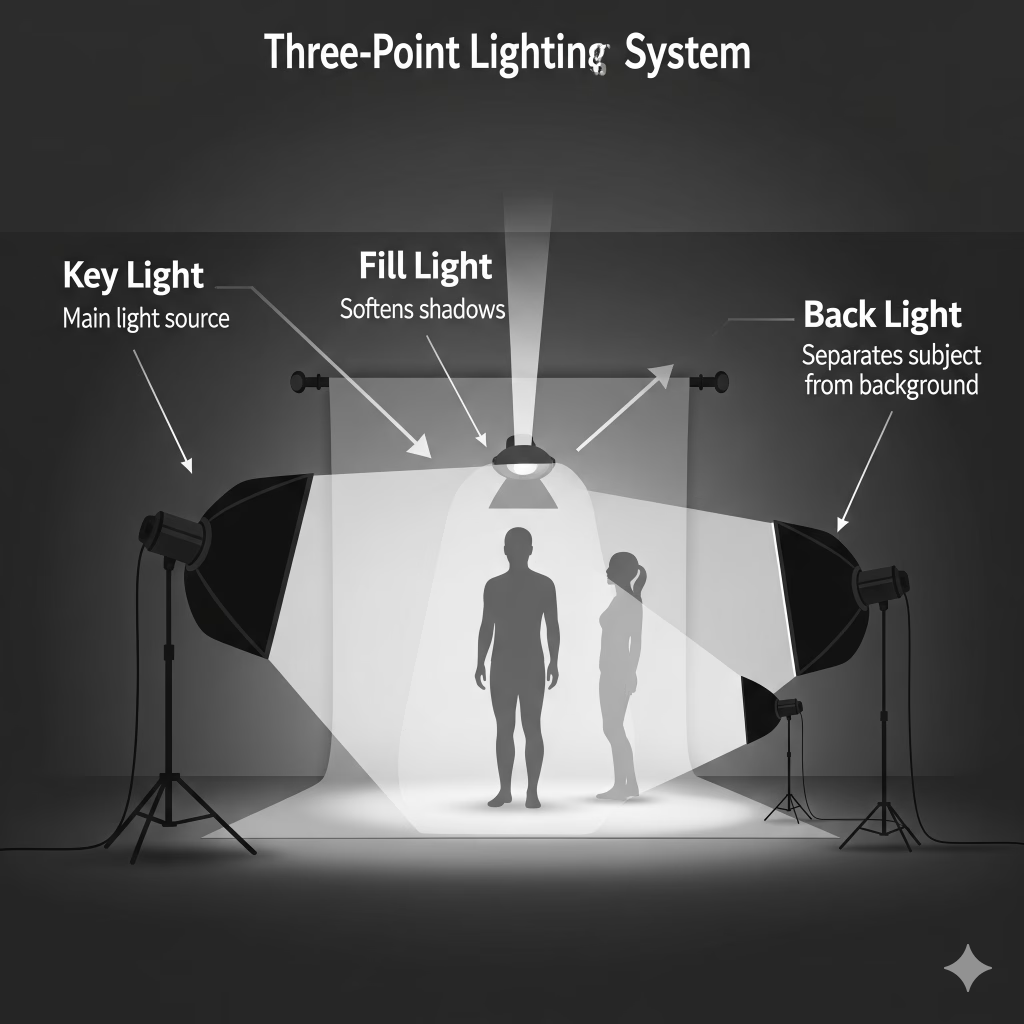
Modern LED panels revolutionized YouTube production. They are lightweight, low-heat, and adjustable. High-end options like the Aputure 120D or Amaran series allow precise color temperature (measured in Kelvin) and dimming, controlled by apps or remotes. For smaller budgets, Neewer and Godox panels offer reliable quality with diffusers to soften light. Diffusion is critical: bare LEDs cast harsh shadows, so softboxes, umbrellas, or diffusion sheets create flattering results. For beauty and lifestyle creators, ring lights remain a staple because they illuminate faces evenly and add distinctive catchlights in the eyes. For creators who record at a desk, a simple LED panel mounted on an arm provides consistent, professional-looking illumination. Understanding color temperature is also key. Warm lighting (around 3000K) conveys intimacy and friendliness, while cooler lighting (5000–6000K) communicates clarity and professionalism. Mixing daylight from windows with warm artificial lights often leads to unnatural skin tones, so controlling and matching color sources is an essential skill.
Background lighting adds personality. RGB LED strips, accent lamps, or practical lights (like a desk lamp or neon sign) bring depth to the scene. Subtle use of color contrasts such as a warm subject against a cool blue background can give a channel a distinctive look that viewers remember. Placement matters as much as color: a small lamp behind a subject can instantly create separation without overwhelming the main lighting. Cinematography principles translate directly into YouTube; understanding how shadows and highlights sculpt a face gives creators the power to produce visually engaging videos even on limited budgets. For examples of cost-effective setups, see GamesRadar Streaming Setup Guide.
Lighting Equipment
- Lighting determines image clarity, depth, and mood. Basic setups use ring lights or softbox kits for consistent illumination, while advanced setups incorporate key, fill, and backlight configurations to create cinematic depth. LED panels like the Aputure 120D or Godox SL60W provide high output with adjustable color temperature. Diffusers and reflectors help control harsh shadows. Understanding three-point lighting principles and color temperature matching ensures professional-looking footage, whether filming indoors or on location.
Audio: Capturing Clear Sound
Audio quality determines perceived professionalism. Many new creators underestimate this, assuming the camera’s built-in microphone is adequate. In practice, on-camera mics capture too much ambient noise and lack clarity. The first upgrade most YouTubers should make is an external microphone. A shotgun mic mounted on the camera isolates the voice from background sounds and works well for talking directly into the lens. Rode, Deity, and Sennheiser produce affordable models with excellent performance. For sit-down content, lavalier microphones clipped onto clothing ensure consistent levels even if the speaker moves. Wireless kits like the Rode Wireless GO II give freedom of movement while maintaining a stable signal, making them popular for interviews, tutorials, and walk-and-talk vlogs.
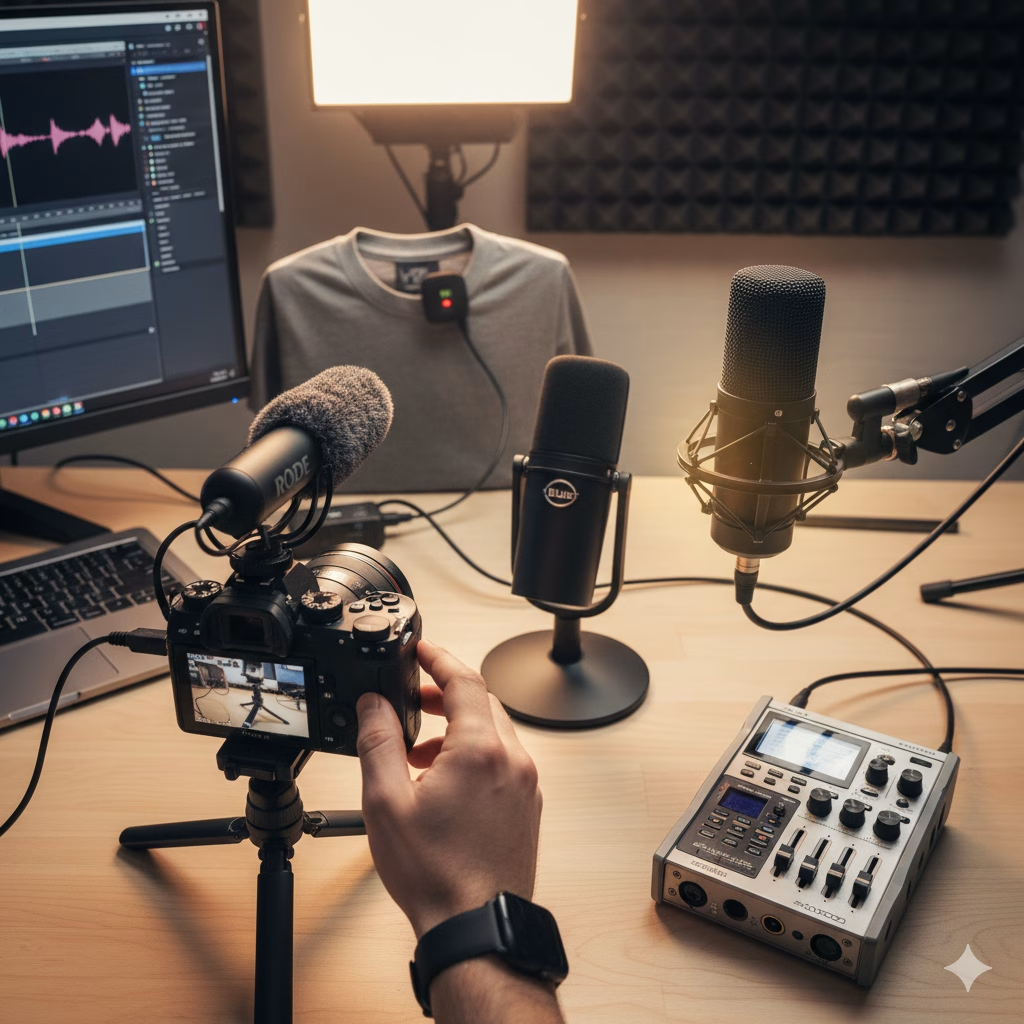
USB condenser microphones, often associated with podcasting, are increasingly common among YouTubers who film at a desk or stream gameplay. Models like the Blue Yeti or Audio-Technica AT2020USB provide studio-level clarity with simple plug-and-play functionality. However, for those serious about audio, XLR microphones paired with interfaces or recorders are the gold standard. A portable recorder such as the Zoom H6 allows multiple tracks, better preamp quality, and flexible setups. Creators can record one track per guest in a podcast or blend instruments and vocals in a music video. This flexibility comes at a cost in complexity, but it creates audio that matches broadcast standards.
The environment matters as much as the microphone. A hardwood-floored room with bare walls will produce echoes and reverb that no microphone can eliminate. Soft furnishings, curtains, rugs, and foam panels absorb reflections, dramatically improving clarity. Simple adjustments like placing bookshelves behind the speaker or recording in a carpeted room can yield noticeable improvements. Monitoring is equally important. Quality closed-back headphones reveal background hums, interference, or clipping that speakers may miss. This allows creators to fix problems during recording rather than discovering them later in editing. For a step-by-step guide to upgrading sound, see WIRED’s YouTube Setup Guide.
Microphones and Audio Gear
- Clear audio is essential; poor sound quality drives viewers away faster than low-resolution video. Lavalier microphones such as the Rode Wireless GO II or Sennheiser AVX are ideal for interviews and mobile shoots. Shotgun microphones like the Rode NTG4+ or Deity D3 Pro excel in directional capture for vlogs or studio setups. USB microphones, e.g., Shure MV7 or Blue Yeti, suit voiceovers or desktop recording. Acoustic treatment in recording spaces reduces echo, while windshields or pop filters improve outdoor and vocal recording quality.
Sound Design and Audio Mixing
- Sound design is more than removing background noise it shapes the emotional tone of the video. Basic steps include synchronizing external microphone tracks with camera audio, applying equalization to remove muddy frequencies, and compressing dialogue so volume remains consistent. Noise reduction plugins can remove hums from air conditioners or distant traffic. Background music, carefully chosen and mixed at a lower level, can energize or soften the mood, though it should never compete with dialogue. Sound effects, such as clicks, swooshes, or ambient noise beds, help smooth transitions or emphasize key moments. Editors typically monitor audio with studio headphones or speakers to catch imperfections that laptop speakers might mask. Reference: Epidemic Sound for royalty-free tracks.
Scaling a Channel: Outsourcing and Teams
As a channel grows, a single creator often cannot manage all tasks filming, editing, branding, marketing, and audience engagement without burnout. Outsourcing becomes essential. Many creators hire freelance editors, thumbnail designers, or scriptwriters through platforms like Upwork or Fiverr. Larger operations may formalize into teams, with dedicated roles for production, postproduction, and social media. Outsourcing not only preserves creative energy but also allows scaling: increasing upload frequency, experimenting with new formats, and pursuing larger brand deals. The transition from solo creator to team leader is a turning point, requiring business skills in addition to creative ones.

Advanced Branding Through Storytelling
At advanced stages, branding is no longer about logos and colors but storytelling. A channel’s narrative why the creator does what they do becomes central to audience retention. This meta-story can be woven into content subtly, whether through recurring motifs, callbacks to earlier videos, or evolving challenges that audiences follow over months or years. Storytelling transforms casual viewers into invested fans who see the creator as more than a content source but as a character in an unfolding journey. This is why some creators sustain careers for a decade while others fade quickly: their brand identity is underpinned by a story that transcends individual uploads.
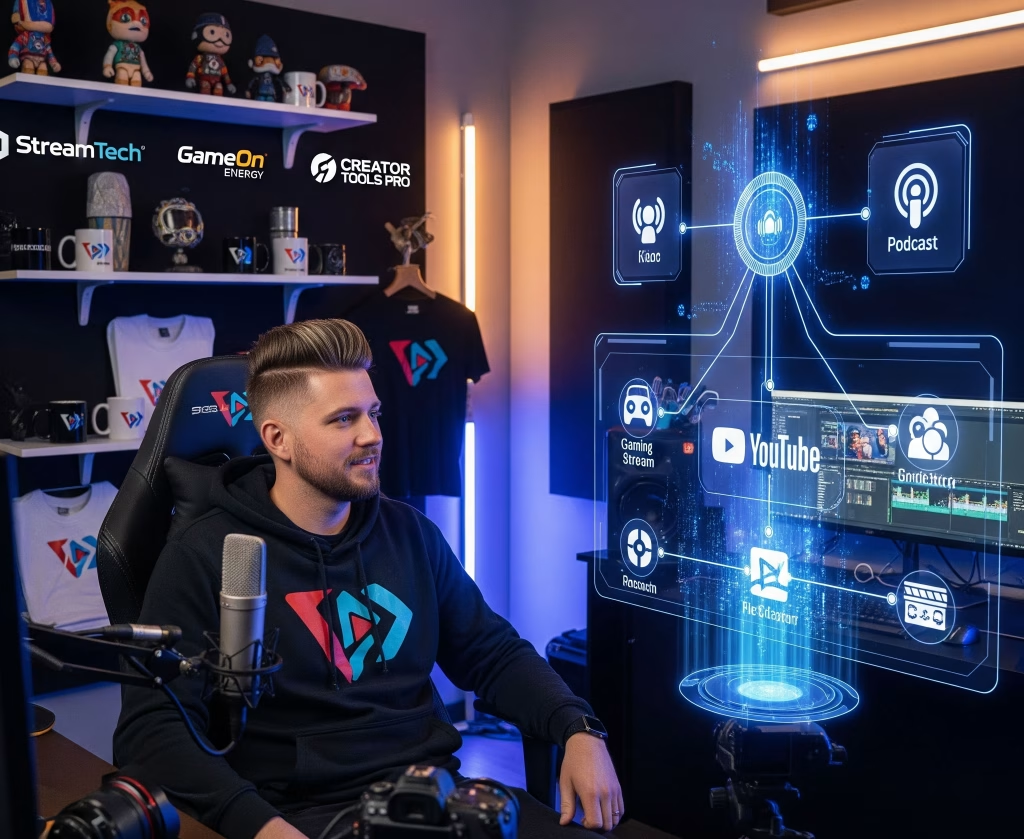
Monetization at Scale
When channels scale, monetization strategies evolve as well. Large channels often establish direct brand partnerships, negotiating six-figure deals that include exclusivity clauses, cross-platform campaigns, or long-term ambassadorships. Some creators diversify further by launching their own product lines, publishing books, or even creating production companies that serve external clients. At this stage, YouTube becomes not just a platform but a springboard into broader media ventures. The advanced creator thinks less about one-off revenue and more about building an ecosystem that sustains growth regardless of algorithm changes. Reference: YouTube Money Calculator.
Understanding Viewer Psychology
Successful YouTube creators think less like broadcasters and more like psychologists. Viewers are not only searching for information or entertainment, they are also looking for a sense of connection. This is why certain creators build cult-like followings while others struggle despite polished production. Human attention operates in patterns: curiosity must be triggered immediately within the first 15 seconds, tension must be sustained throughout, and a sense of reward must be delivered by the end. Creators who understand the psychology of anticipation, surprise, and satisfaction can shape their content like a narrative experience rather than a static lecture. Neuroscience research consistently shows that emotional hooks whether humor, empathy, or suspense anchor memories more effectively than raw facts. Reference: Psychology of Attention – Psychology Today.

Retention and Watch Time
YouTube’s algorithm rewards watch time above almost all other factors. High retention rates signal to the platform that a video is valuable, leading to wider recommendations. Retention begins with pacing: long pauses, repetitive phrases, or irrelevant tangents cause drop-offs. Techniques to hold attention include structuring videos into clear segments, using pattern interruptions such as camera angle changes or sound effects, and delivering continuous value without filler. Graphics and on-screen text reinforce information, keeping the viewer engaged even when their attention might drift. Savvy creators analyze their retention graphs in YouTube Analytics to identify exact timestamps where audiences lose interest, then refine future scripts to eliminate those pitfalls. Reference: YouTube Analytics Guide.
Engagement Triggers
Engagement is not accidental; it is engineered. Calls to action such as “like and subscribe” have become clichés, but when integrated organically, they still work. More sophisticated triggers include cliffhangers at the end of a video that drive viewers to the next upload, or direct challenges that encourage comments (“Tell me in the comments what your biggest obstacle is…”). Giveaways and contests also stimulate interaction, though they should not replace intrinsic content value. Ultimately, engagement triggers are psychological nudges that transform a passive viewing experience into an interactive loop, increasing both retention and algorithmic favor.
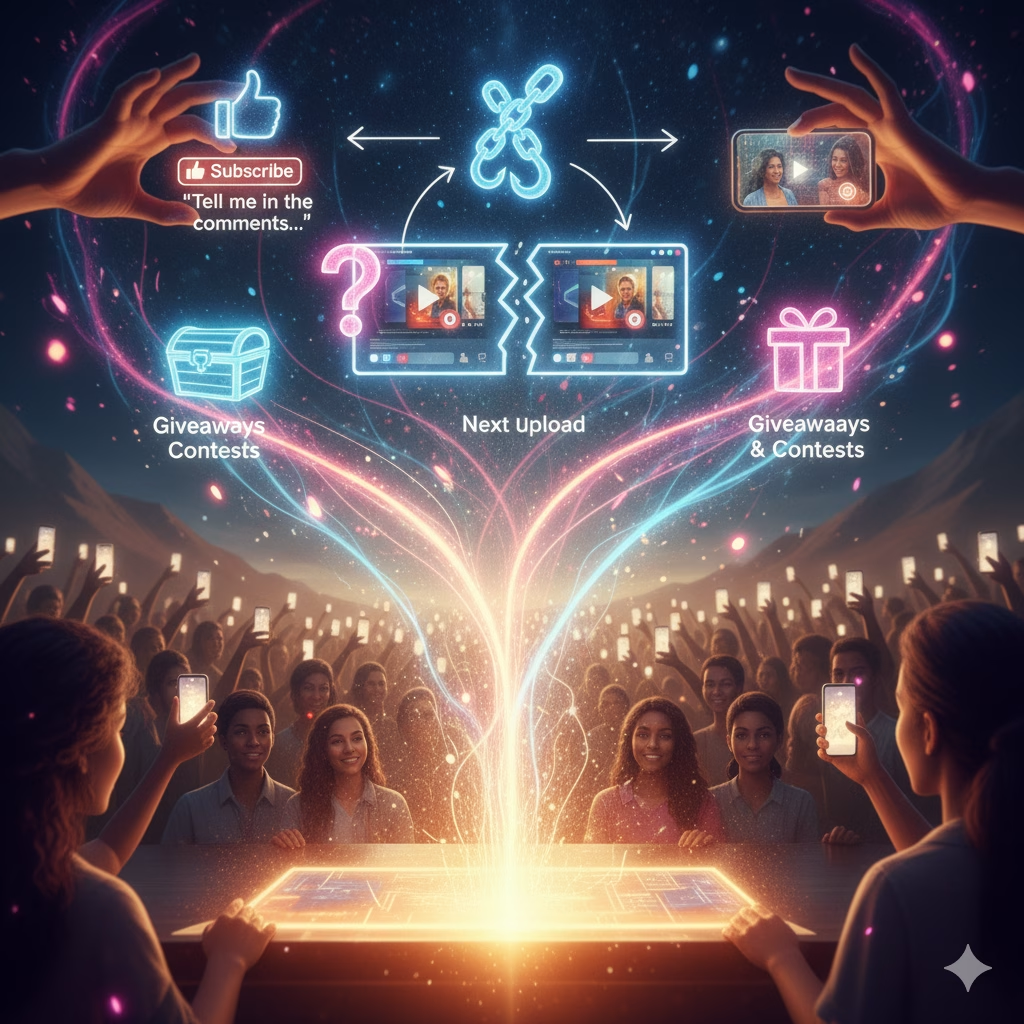
Identifying Your Niche
Choosing the right niche is foundational for YouTube success. A niche is not just a topic it is a combination of subject matter, audience needs, and creator expertise. Broad niches such as “lifestyle” or “gaming” are saturated, making discoverability difficult for new channels. Micro-niches, for example “budget travel in Southeast Asia” or “retro synthesizer tutorials,” allow creators to target a specific, highly engaged audience. A well-defined niche also facilitates consistent content planning, branding, and audience development. The process often begins with an inventory of personal skills, passions, and knowledge areas, then cross-referencing against market demand using keyword tools, search volume analysis, and competitor audits. Channels that combine unique perspective with underserved niches tend to grow faster and retain viewers longer. Reference: TubeBuddy Keyword Tools.
Building a Long-Term Brand
YouTube success is inseparable from branding. Over time, creators establish not only visual style colors, fonts, intro/outro sequences but also thematic identity and audience expectations. This identity informs collaborations, sponsorships, and merchandising opportunities. Channels that maintain coherent branding across videos, social platforms, and community interactions create a professional ecosystem that viewers recognize and trust. Long-term branding reduces dependency on the algorithm: loyal audiences will seek out content even when discoverability fluctuates, creating a more stable and monetizable channel.
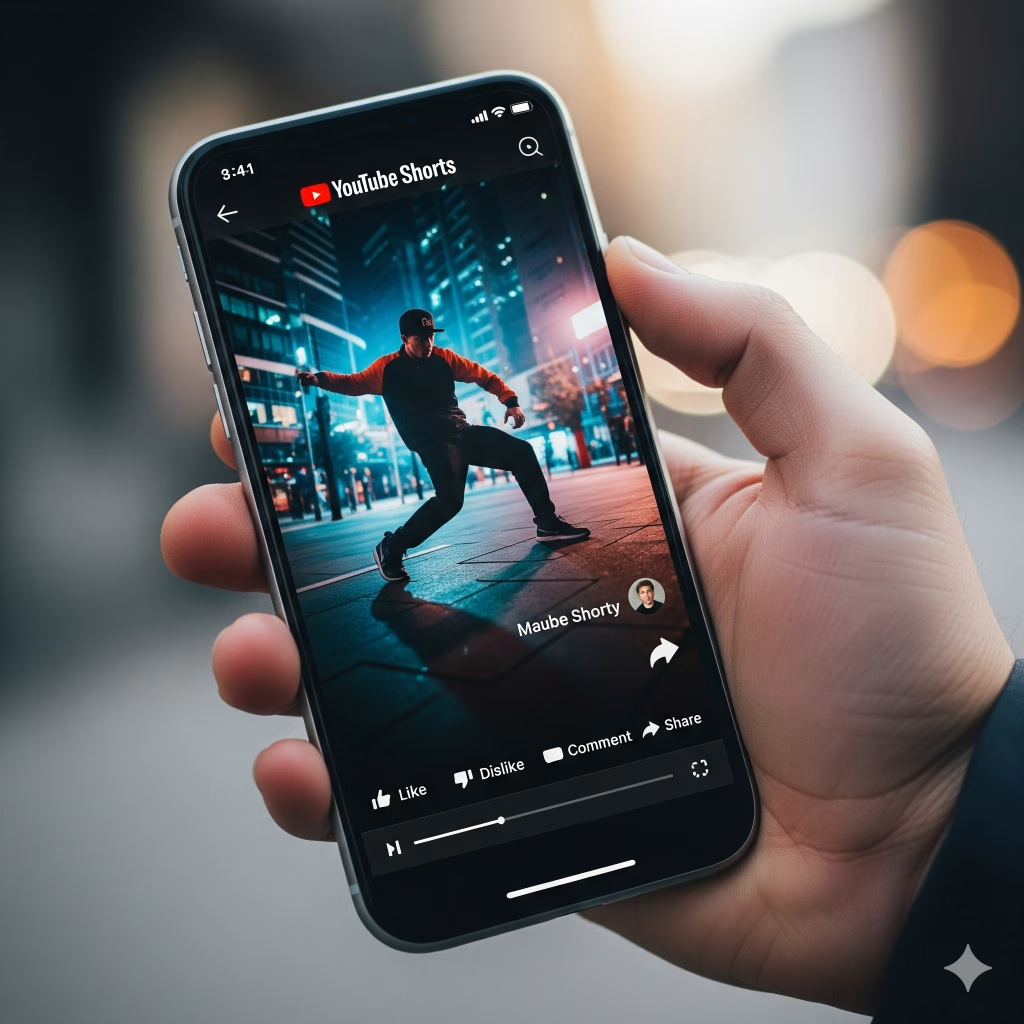
The Rise of YouTube Shorts
YouTube Shorts represent the platform’s response to TikTok and Instagram Reels, emphasizing vertical, bite-sized content that captures attention quickly. Shorts are limited to 60 seconds, making pacing, hook, and clarity essential. The format encourages experimentation with trends, quick tutorials, micro-vlogs, or humorous snippets. Creators should prioritize immediate engagement: the first 3–5 seconds determine whether viewers continue watching. Unlike traditional long-form videos, Shorts are often discovered via the Shorts shelf and algorithmic recommendations rather than search, making virality more accessible for new creators. Reference: YouTube Shorts Overview.
Vertical Video Editing Workflow
Editing vertical content requires a specialized approach. The timeline should match a 9:16 aspect ratio, ensuring that all overlays, text, and visual effects are visible on mobile screens. Motion graphics must be scaled and repositioned accordingly, avoiding cropping of key subjects. Color correction and grading are equally important, even for shorts, as aesthetic consistency reinforces brand identity. Audio balancing must prioritize clarity over spatial ambiance, given that viewers often consume Shorts in noisy environments. Rapid iteration is common: multiple short cuts are tested to maximize retention, with analytics guiding decisions about pacing, hooks, and visual storytelling techniques.
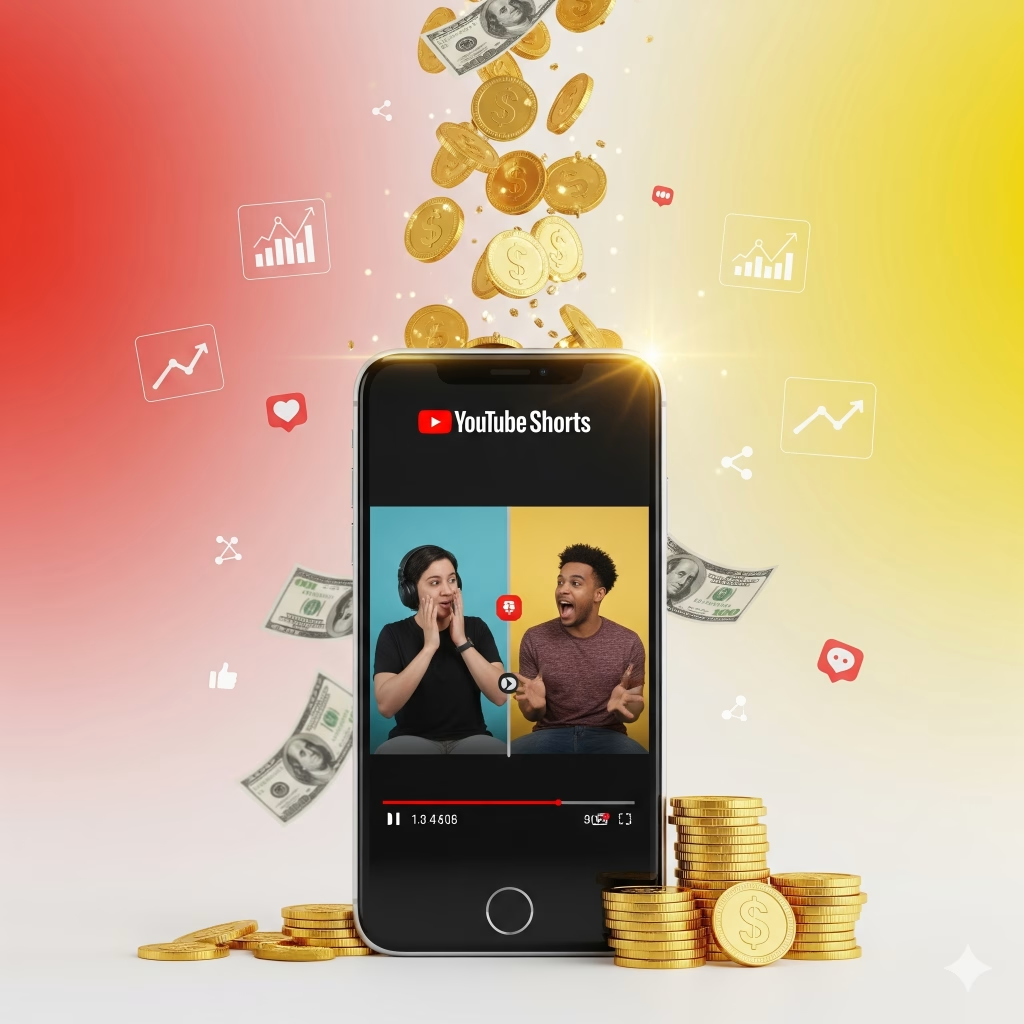
Embedding and Sharing Content Externally
Embedding YouTube videos on blogs, websites, and newsletters enhances discoverability and drives traffic back to the channel. Creators with personal websites can integrate videos into articles or tutorials, improving search engine optimization (SEO) while maintaining brand authority. Social bookmarking sites like Reddit, niche forums, or relevant online communities also offer opportunities for targeted sharing. However, context is critical: simply posting a link without engaging with the community often leads to negative feedback or removal. Thoughtful integration, commentary, and discussion encourage organic engagement while positioning the creator as a trusted expert within specific niches.
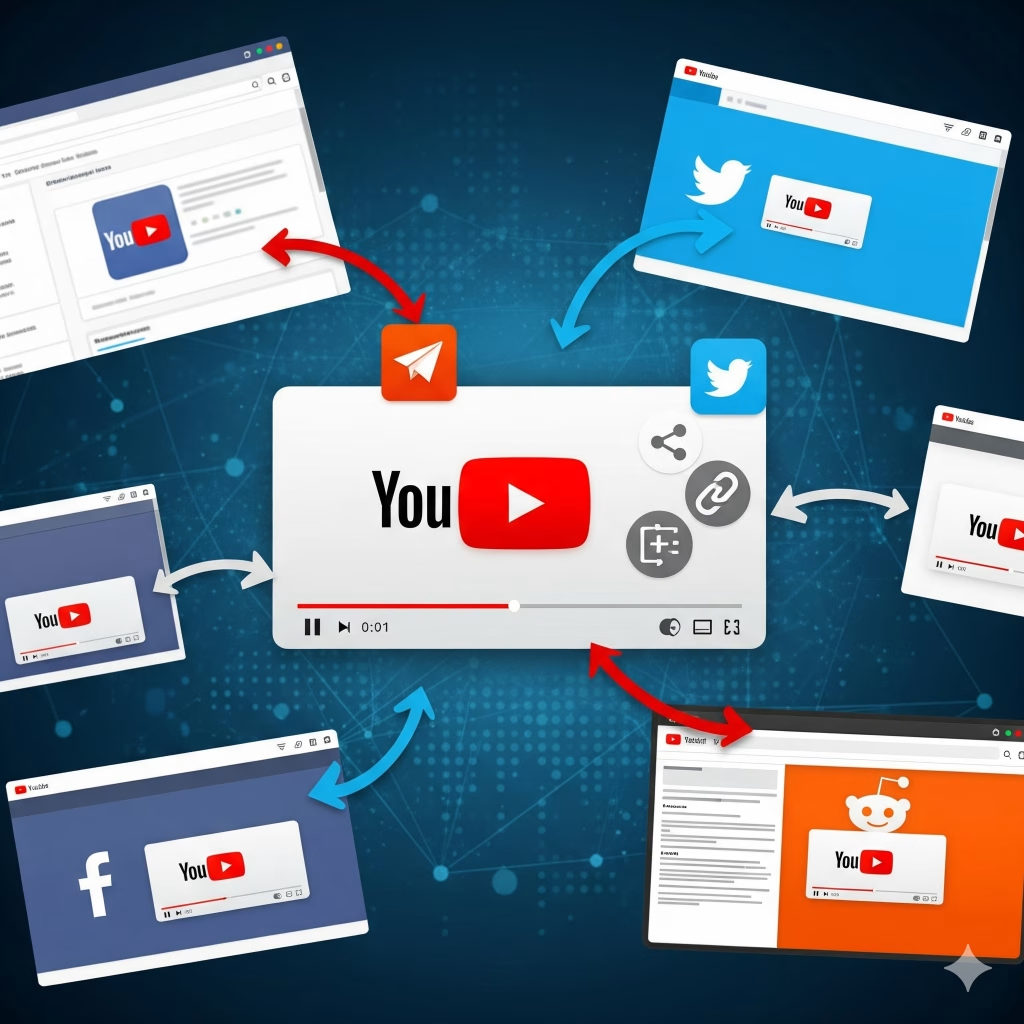
Advertising and Sponsorship Compliance
Disclosure requirements are legally mandated in many regions. Sponsored content, affiliate links, or product placements must be clearly labeled to comply with regulations such as the FTC guidelines in the United States or equivalent authorities internationally. Failure to disclose partnerships can result in fines, strikes, or damage to audience trust. Creators often use on-screen text, verbal disclosure, or description notices to maintain transparency while integrating monetization seamlessly. Reference: FTC Endorsement Guidelines.
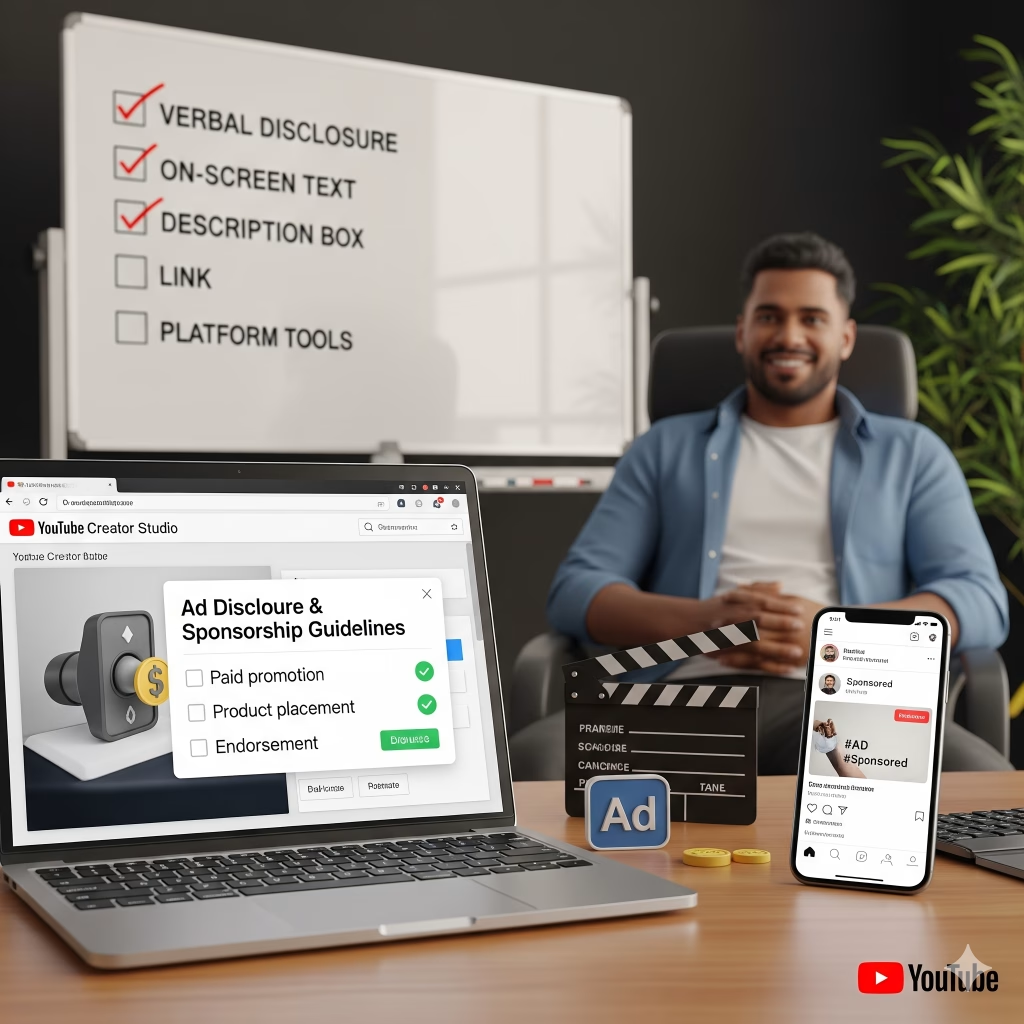
Artificial Intelligence in Content Creation
AI is increasingly integrated into video production workflows. Tools like ChatGPT, Jasper AI, and Synthesia assist with scriptwriting, content ideation, and even AI-generated avatars for presentations. AI-driven analytics platforms predict trending topics, optimize upload times, and provide audience segmentation insights. Video editing software such as Adobe Premiere Pro now integrates AI-based scene detection, auto-reframing, and color correction, reducing editing time while improving visual quality. While AI enhances efficiency, creators must maintain human oversight to ensure authenticity and maintain brand voice.

